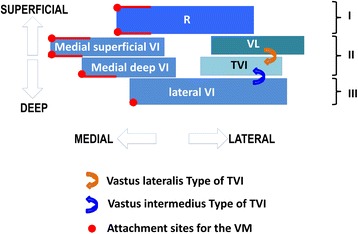Fig. 5.

Schematic drawing of the three-layered architecture of the quadriceps tendon. The superficial layer (I) of the quadriceps tendon is formed by the tendon of the rectus femoris (R). The intermediate layer (II) is further sub-divided. The tendon of the vastus intermedius (VI) itself shows a complex multi-layered structure consisting of the lateral part of the vastus intermedius aponeurosis (lateral VI) and the medial deep and medial superficial layers of the vastus intermedius aponeurosis. The medial superficial and the medial deep layer of the vastus intermedius aponeurosis fuse with the aponeurosis of the tensor vastus intermedius (TVI) and vastus lateralis (VL), respectively. The lateral part of the vastus intermedius aponeurosis forms the deepest layer (III) of the quadriceps tendon. In some cases, the aponeurosis of the tensor vastus intermedius emerges either from the lateral part of the vastus inermedius (bended blue arrow) or vastus lateralis (bended orange arrow) (Grob et al.). The vastus medialis (VM) is not directly involved in the architecture of the quadriceps tendon. It inserts into the aponeurosis of the vastus intermedius and tendon of the rectus femoris on its anterior and posterior side (indicated by the red dots and lines)
